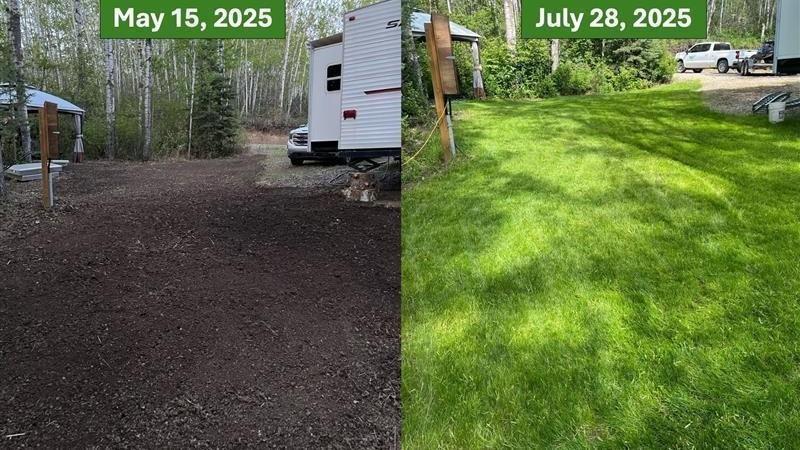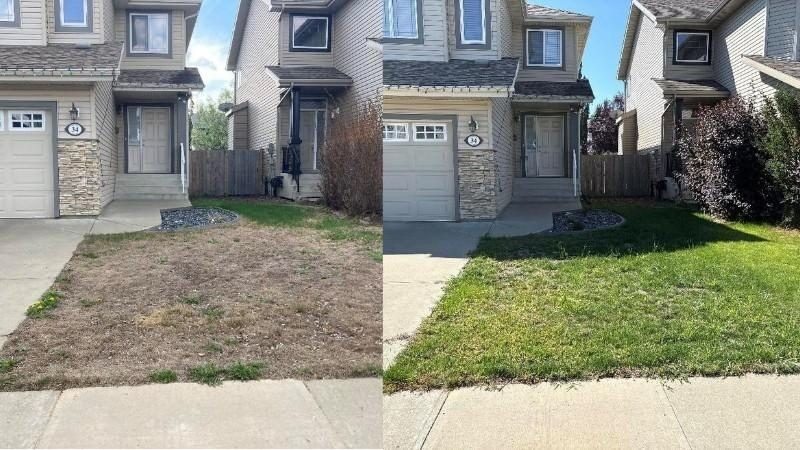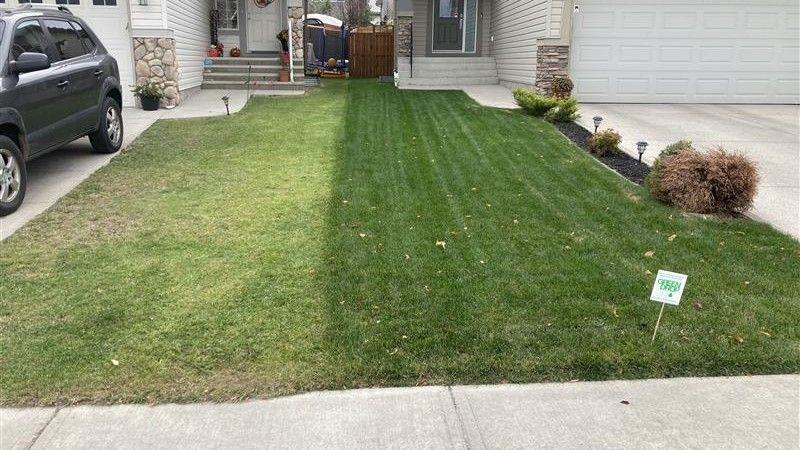How Long Does It Take To See Results After Overseeding Your Lawn?
Reading time: 6 - minutesOverseeding is one of the best ways to bring a tired lawn back to life, especially when combined with aeration. It thickens turf, fills bare spots, and helps your grass resist weeds and disease.
But here’s a question most people ask: how soon can you expect to see overseeding results?
Let’s break down different scenarios:
Scenario 1: A Completely Bare Lawn
If your lawn is essentially bare, it’s not really overseeding.
Planting grass seed on bare soil is generally called seeding (or sometimes new lawn seeding if you’re starting fresh).
Overseeding is when you spread grass seed over an existing lawn to thicken it, fill in thin patches, or introduce a better grass variety.
This will take the longest to show results because you’re starting from scratch.
First sprouts usually appear in 1 to 3 weeks, but full coverage can take 6 to 10+ weeks. Even then, the lawn may look patchy until the following spring. This might seem like a long time, but a bare lawn needs heavy seeding and careful watering to avoid dry-outs. The new grass is vulnerable until roots spread and the canopy thickens.
Here is one of the lawns we did this year…

Some tips for seeding a bare lawn:
- Clear debris like rocks, weeds, and any dead grass.
- Rake or lightly till the top 2–3 inches so seeds can make contact with the soil.
- Smooth bumps and fill low spots to prevent puddling.
- Aerate and topdress to improve seed-to-soil contact.
- Use quality seed as higher-grade blends germinate better and are less likely to contain weeds.
- Lightly water 1–2 times a day until seeds sprout. Don’t flood it. Overwatering can wash seeds away. Aim for consistently damp, not soggy, soil.
- Don’t mow until the grass is at least 3–4 inches tall.
- Stay off the lawn. Foot traffic compacts soil and damages seedlings.
Note: Early fall and spring are ideal. Temperatures are mild, and there’s usually more natural rainfall. Avoiding summer heat and deep winter cold makes germination tough.
You’ll see green shoots this fall, but the real payoff is next spring when those seedlings return with stronger roots and better density.
Scenario 2: Large Bare Patches in an Existing Lawn
When your lawn has some grass but also big bald spots, overseeding works well. You’ll need patience, though, because sprouts will take 7 to 14 days. Visible fill-in usually happens within 3 to 4 weeks. By next spring, the patches should blend with the rest of the yard.
Keep in mind, large patches can dry out faster than established grass. Seedlings on the edges compete with older turf for water and nutrients.
Here’s another before and after shot of our aeration and overseeding…

Some tips for overseeding a lawn with bare patches:
- Aerate before overseeding so the seed can settle into the soil.
- Water consistently, especially at the edges of bare spots.
- Avoid mowing until seedlings reach at least 3 inches.
By fall you’ll see coverage, but the lawn won’t look uniform until spring growth evens everything out.
Scenario 3: A Weed-Heavy or Thinned Lawn
Overseeding into a weed-infested yard can be tricky. The seed will germinate, but weeds tend to fight for space, water, and sunlight. Weeds shade and crowd seedlings. Without treatment, new grass struggles to thrive.
You can expect sprouts to emerge in 2 to 3 weeks, but visible improvement may lag until weeds are controlled. You should expect more noticeable results after one or two overseeding cycles combined with weed management.
Some tips for overseeding a weed-heavy lawn:
- Use post-emergent weed control for broadleaf weeds before overseeding.
- Aerate to loosen soil and reduce compaction.
- Fertilize lightly to help seedlings outcompete weeds.
- Overseed again in spring if weeds were dense.
It’s important to note here that overseeding alone won’t solve a weed problem. We need to pair it with weed control for real results.
Patience is key here, and the payoff comes after multiple growing cycles.
Scenario 4: Mostly Healthy Lawn with Thin or Brown Spots
This is the best-case overseeding scenario. A lawn that’s already in decent shape responds quickly to overseeding, and results often look impressive by fall.
Healthy grass already shades soil, retains moisture, and protects seedlings. Overseeding adds density without starting from scratch.
Sprouts appear in 7 to 14 days. By 2 to 3 weeks, you’ll see thicker coverage and healthier colour. By the next spring, your lawn should be noticeably lusher.
Here’s what we’re talking about…

Tips for overseeding a mostly-healthy lawn:
- Overseed right after aeration for maximum seed-to-soil contact.
- Keep watering steadily. Thin areas dry out more quickly.
- Maintain mowing height at 3 inches to protect young shoots.
This is where homeowners often get the fastest results. You’ll see improvement this season, with a major boost in the spring.
Scenario 5: Recovery After Insect Damage
Insects like grubs and chinch bugs can affect a lawn, leaving bare patches or dead-looking turf.
Overseeding helps, but only after the root cause is addressed. Without treatment, pests will keep feeding, and new seedlings won’t survive. Damaged soil may also be disturbed by animals digging for grubs.
Once pests are treated, sprouts usually emerge in 1 to 3 weeks. Because insect damage severs roots, it may take 4 to 8+ weeks for the lawn to look whole again. The biggest recovery comes the following spring.
Tips for overseeding an insect-infested lawn:
- Treat the pest problem first.
- Aerate, overseed, and fertilize to encourage regrowth.
- Water consistently and limit traffic on damaged spots.
Overseeding works after insect damage, but patience is required. Expect slow improvement in fall and a stronger comeback the next season.
Scenario 6: Overseeding After Drought Stress
This is common in Western Canada, where hot, dry summers leave lawns patchy or dormant. Overseeding helps revive these lawns, but recovery is slower if soil moisture is inconsistent. Drought-stressed soil can be compacted and hydrophobic (repels water). Without proper watering, the seed dries out.
Sprouts in 1–2 weeks if the soil is kept damp, but visible thickening may take 4–6 weeks. Full uniformity often waits until the following spring.
Tips for overseeding a lawn after drought:
- Aerate to break compaction before overseeding.
- Water deeply but less often to retrain the soil.
Overseeding works, but recovery hinges on consistent post-seeding moisture.
Overseeding Pays Off Always, But Requires Patience
How long it takes to see results after overseeding depends on where you’re starting:
- Bare soil takes the longest
- Thin or brown patches recover fastest
- Weed-heavy and insect-damaged lawns need extra steps
In every case, you’ll see green sprouts in a few weeks, but the true transformation comes the following season. However, you must prep properly and care for seedlings.
At Green Drop, we make overseeding simple with the highest likelihood of success…because we know lawn care.
We always overseed after aerating and provide watering guidance so your new grass has the best chance to thrive.
Get professional lawn care services in Winnipeg, Calgary, Red Deer, Edmonton, Saskatoon, and Regina to get thicker, healthier lawns season after season.
Book your fall aeration and overseeding today and give your lawn the head start it needs before winter sets in.

